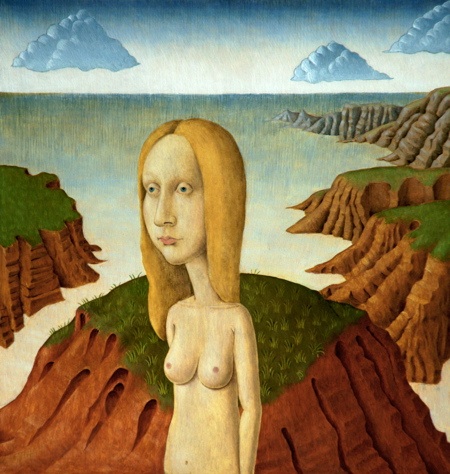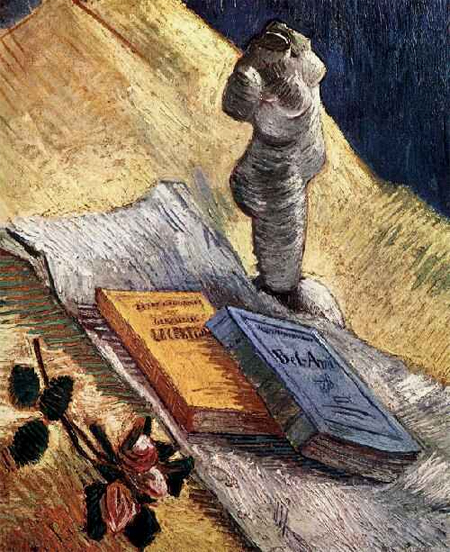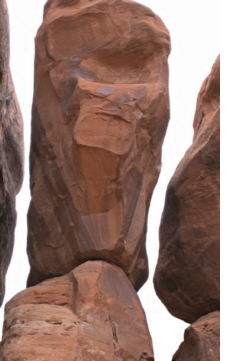I had the good fortune to go to a very good group show at the MoMA recently with the provocative title ‘What is painting?’. One among the many works that I ran into was by a lady artist of the 1970’s Lee Lozano. Not having studied at art school, I did not know much about her (well, I did later find out that she really is not a household name) until I came back home and read up a little bit about her. The more I read, the more I was fascinated by how she had managed to integrate art and life into a seamless whole. From reading, I surmised that her desire for painting went beyond the confines of the canvas and she tried through her art/life to incorporate the viewer and her life in a strange union.
Archives for painting
Foamula (by Jay)

OHIO TOWN – varnish on figured foam – 2005
You, especially if you patrol the aisles of building supply stores, have run across sheets of a light, pink material, used for insulation. Foamula is a common trademark.
A look back at a painting from ’99

This painting from 1999 is made with oil colors on a chalk ground on a wood panel. There are interesting aspects to this picture that make me want to take another look at it.
I like the mood that the colors and rhythms of the landscape give in contrast to the pale woman.
The rhythms of the grass and the receding landscape, the whites of the clouds, each sets up its own system. The woman in contrast has a simple rhythm of points — her nipples mirror her eyes. She is still and silent, but the landscape seems to reflect the texture of her thoughts and feelings — this is how I see it. The sharp edges and mellow forms are part of this texture.
All the oddness of the painting holds together because of its “internal coherence”, to borrow Arthur‘s expression.
I think that taking a careful look at older work is important because along the way I sometimes loose site of the things I did before, perhaps because I didn’t appreciate them earlier. Have you ever “rediscovered” an older work of your own, finding something in it you never saw before?
perspectives and shadings
Looking for imaginative interpretations of perspective by Vincent van Gogh, I came across his Still Life with Plaster Statuette, a Rose and Two Novels. It reminded of someone else’s still life posted earlier on A&P that was critiqued for grapes that seemed to be sliding of an underlying cloth.

Artists I Like: Nava Lubelski
My taste in art—especially painting and drawing, but also other mediums—tends towards the strange, the mutant, the science fictionesque. This isn’t because I hate nature, but rather because I feel that art should offer something else, a surrogate (as Jackson Pollock once famously said to Hans Hoffman, “I am nature”). This kind of stuff probably isn’t to everybody’s taste, but what the hell.
I’ve been interested in Nava Lubelski’s paintings for something like three years. They seemed a bit lightweight when I first discovered them at Boston’s OHT Gallery. They’ve grown on me since then and I think the pieces themselves have gotten less uneven. Her method is unusual. She stains and splatters her canvases with thin washes of ink and acrylic paint in different colors. She then hand-stitches thread (again in various colors), tracing the outlines of the stains and creating new patterns as well. Some her recent canvases even have holes in them; A Lie About Birds and Bees is an impressive example. The results are reminiscent of abstract expressionism, as well as the post ab-ex tradition of color field painting. They also evoke birds-eye views of landscape or snorkeling—favorite themes of mine. At their best, the canvases are fascinating, intricate things.
In her artist’s statement, Lubelski describes her process in terms foreign to those of the stereotypically masculine world of abstract expressionism. She describes her staining as “spoiling” and her stitching as “mending”. The pieces are meant to suggest a duality of accident or wildness versus care and precision. I’m not a woman, but I do find this approach congenial.
Lubelski is also the author of a book: The Starving Artist’s Way. I haven’t read it, but it appears to be a sort of bohemian do-it-yourself guide. Her website also features several drawings and mixed-media sculptures (my favorite).
Rock face
 When I first showed these rock formations I’m calling Bones of the Earth, I was quite unsure what to do with them (I still am…). They seemed to invite a number of treatments. In particular, I found myself wishing I could paint them. Since I’d been admiring Sunil’s paintings of late, I naturally wondered how he might handle them: “Sunil, are you out there? Imagine these rocks as a weathered old face, what would you do with it?” I was not thinking that Sunil would actually see a face in them, but rather that considering the rock surface as skin might suggest coloring and brushwork that would give an interesting treatment. That was before my own musings on the power of face recognition. And if anyone has an over-developed fusiform gyrus in his brain, it’s Sunil (I can barely rotate 90 degrees, he easily does 180). Well, as you can guess, Sunil did see a face there — in fact three — and has recently posted on his blog the painting that resulted. It’s reproduced (with permission) below:
When I first showed these rock formations I’m calling Bones of the Earth, I was quite unsure what to do with them (I still am…). They seemed to invite a number of treatments. In particular, I found myself wishing I could paint them. Since I’d been admiring Sunil’s paintings of late, I naturally wondered how he might handle them: “Sunil, are you out there? Imagine these rocks as a weathered old face, what would you do with it?” I was not thinking that Sunil would actually see a face in them, but rather that considering the rock surface as skin might suggest coloring and brushwork that would give an interesting treatment. That was before my own musings on the power of face recognition. And if anyone has an over-developed fusiform gyrus in his brain, it’s Sunil (I can barely rotate 90 degrees, he easily does 180). Well, as you can guess, Sunil did see a face there — in fact three — and has recently posted on his blog the painting that resulted. It’s reproduced (with permission) below:
Chance in art

Painting From Life vs. From Photos

I always enjoy painting skies. Part of the reason, I think, is that I never know the result ahead of time. The process of painting the skies is not entirely random, of course, but within the system of constraints I use, there is a large element of chance as to how they will develop. A slight unevenness in the over-painting blue becomes the seed of a cloud. The negative space of one cloud becomes the seed of another cloud. And so forth . . .
There is a big difference from photography here in the unfolding interaction with chance. A lucky photograph is made in milliseconds. Perhaps the result will inspire more photographs to capture the moment; but each photograph achieves its essential identity with the press of a button. Painting the skies is something more like an ongoing improvisation, technical context providing a stable base rhythm. The effects of chance are something I can explore over hours and days in the context of a single image.
Sunil’s post about luck in photography got me thinking about the role of chance in art. I wonder, is there an element of art that does not develop from some chance event? I’m on the verge of saying, art is about the harnessing of chance — except that is an oversimplification, and also I remember hearing it somewhere else before.
And yet, what is the alternative to the random? Religion informs us of the notion of Free Will. Science reminds us that there is only the random and the deterministic. Which makes better art?